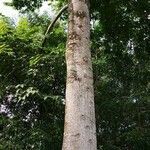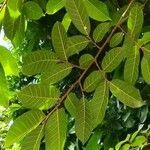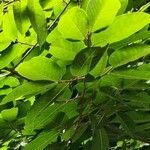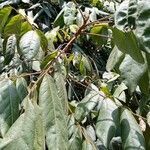Trees 25-40 m tall, d.b.h. 30-40 cm, occasionally with buttresses when large. Bark gray, coarse. Branchlets brown pubescent when young, furrowed when dry. Stipules lanceolate, caducous. Petiole 5-8 mm, with long thick hairs; leaf blade elliptic to obovate but narrowly elliptic on mature plants, 7-19 × 3-6 cm, abaxially pale green but brown when dry and densely covered with long thick hairs but more densely so along main veins, adaxially dark green and sparsely covered with long thick hairs, base rounded to ± cordate and asymmetric, margin serrate, apex acuminate; secondary veins 10-13 on each side of midvein, apically inflexed. Male inflorescences ca. 1.5 cm wide; involucral bracts triangular, boatlike, outside pubescent. Female inflorescences pear-shaped, 1-flowered, covered by numerous bracts. Male flowers: filament very short; anthers ellipsoid, with purple spots. Female flowers: without sepals; style 2-branched, subuliform, pubescent. Drupes bright red to purple red, pear-shaped, ca. 2 cm in diam. when mature. Fl. Mar-Apr, fr. May-Jun.
Leaf lamina elliptic to oblong or almost obovate, when juvenile often lanceolate, (2)6–15(32) x (1.5)3–12 cm., coriaceous, often chartaceous when juvenile; apex shortly acuminate to obtuse or subacute; base obtuse to subcordate or sometimes subacute; margin subentire or denticulate, often dentate when juvenile; superior surface puberulous or scabridulous, hirtellous on the midrib; inferior surface puberulous, hispidulous, sometimes tomentose; lateral veins (5)7–14 pairs, tertiary venation partly scalariform; petiole 3–10 mm. long; stipules 3–10(15) mm. long, caducous.
A tree. It loses its leaves during the year. It grows 30-45 m high. The trunk is straight and normally only has branches above 25 m high. The trunk can be 180 cm across. There are buttresses 3 m high. The leaves are alternate and simple. The leaves are 6-20 cm long by 3-12 cm wide. There are 1-8 flowers in a group in the axils of leaves. The male and female flowers are separate. The fruit is oval and fleshy. The fruit stalk is large and fleshy. They are 1-1.5 cm long and have 1 seed. The seeds are 7-9 mm long. There are 5 subspecies.
Pistillate inflorescences 3–4 cm. in diam., sessile or with a peduncle 3–6 mm. long; stigmas (2)5–8(10) mm. long.
Staminate inflorescences 0.6–1.2(2) cm. in diam.; peduncle 5–15(18) mm. long.
Infructescences ellipsoid, sometimes ovoid or globose, 1–1.5 x 0.8–1
See Antiaris toxicaria subsp. macrophylla (R.Br.) C.C.Berg
Tree up to 40(60) m. tall.





